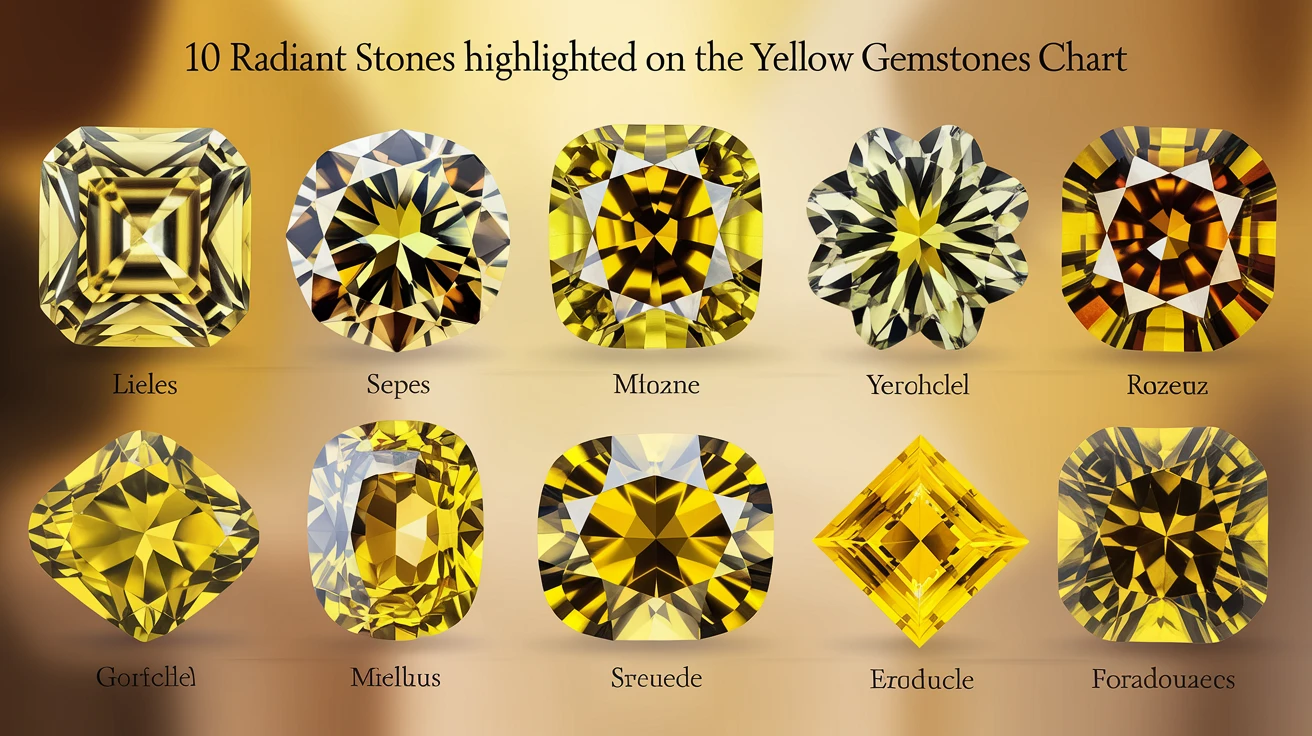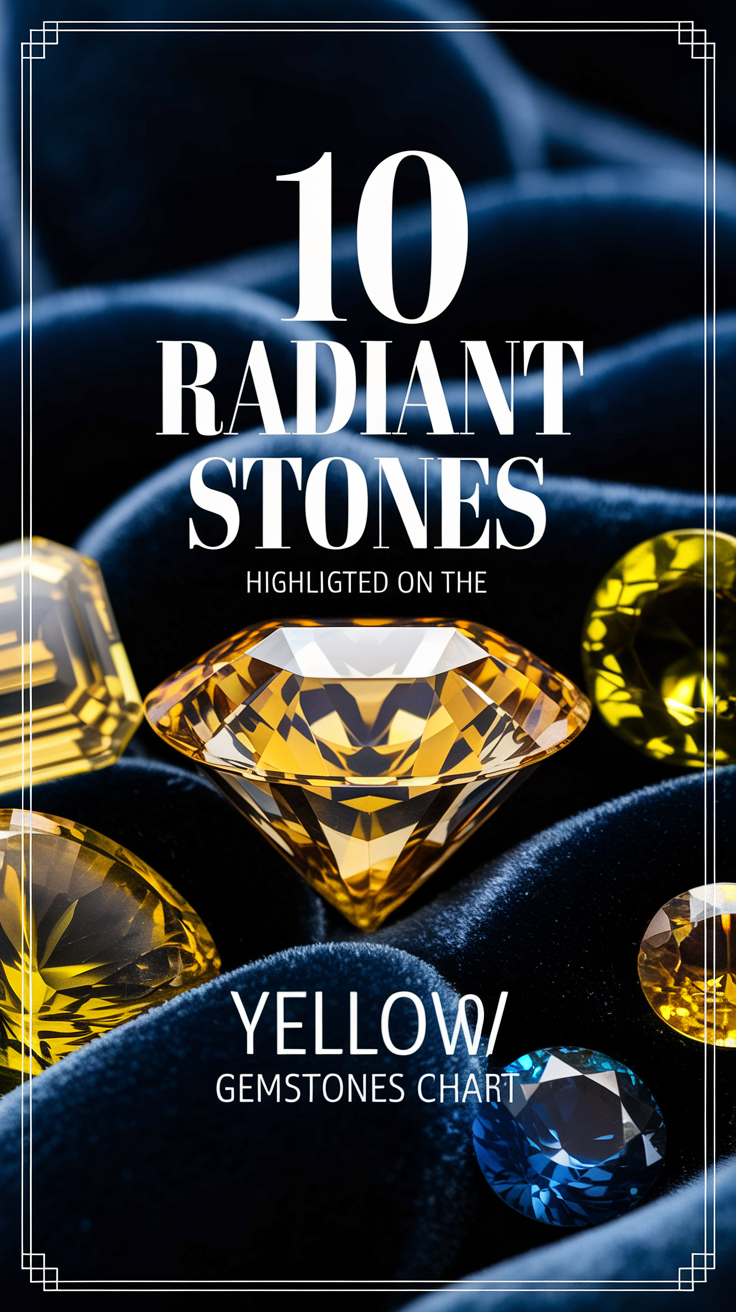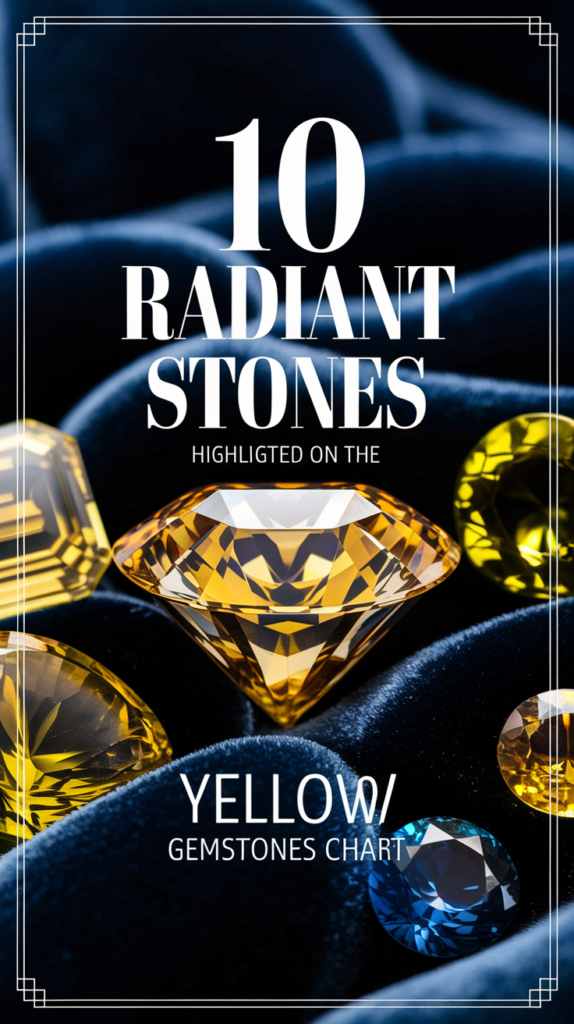
Introduction to the World of Yellow Gemstones
The yellow gemstones chart represents a fascinating spectrum of nature’s most radiant treasures. From the brilliant yellow diamond to the sunny citrine, these stones capture the essence of warmth and light in their crystalline structures. Understanding these magnificent gems can help you make informed decisions whether you’re a collector, jewelry enthusiast, or simply admiring their beauty.
| Gemstone | Mohs Hardness | Typical Clarity |
|---|---|---|
| Yellow Diamond | 10 | VS to SI |
| Yellow Sapphire | 9 | VVS to VS |
| Citrine | 7 | Eye Clean |
1. Citrine: The Merchant’s Stone
Citrine, often called the “merchant’s stone,” leads our yellow gemstones chart with its affordable luxury and stunning golden hues. This variety of quartz ranges from pale yellow to deep amber, making it one of the most versatile yellow gemstones available.
- Natural color ranges from pale yellow to honey brown
- Most commercial citrine is heat-treated amethyst
- Excellent durability for everyday wear
- Available in large sizes at reasonable prices
As a member of the quartz family, citrine offers excellent value for those seeking yellow gemstones. Its clarity and brilliance make it a popular choice for statement jewelry pieces and investment collections alike.
Pro tip: When shopping for citrine, look for stones with even color distribution and avoid pieces with obvious color zoning, as these may indicate artificial treatment.
2. Yellow Sapphire: The Royal Choice
Yellow sapphire holds a distinguished position on the yellow gemstones chart as one of the most precious and durable options. These stunning stones belong to the corundum family and offer exceptional brilliance and fire.
- Extremely durable with a Mohs hardness of 9
- Natural stones range from pale yellow to rich golden
- Excellent clarity and transparency
- Highly valued in both jewelry and investment markets
The remarkable durability and beauty of yellow sapphires make them ideal for everyday wear, especially in engagement rings and family heirlooms. Their rarity and quality contribute to their significant value in the gemstone market.
Pro tip: Choose yellow sapphires with medium to medium-dark tones for the best value and most appealing appearance.
3. Yellow Diamond: The Ultimate Luxury
Yellow diamonds represent the pinnacle of luxury on any yellow gemstones chart. These fancy-colored diamonds combine the unmatched hardness of diamond with spectacular yellow hues, creating truly exceptional gems.
- The hardest natural substance (Mohs 10)
- Colors range from light yellow to intense “canary” yellow
- Exceptional brilliance and fire
- Among the most valuable yellow gemstones
Yellow diamonds owe their color to nitrogen atoms within their crystal structure. The more concentrated the nitrogen, the more intense the yellow color becomes, affecting both beauty and value.
Pro tip: When investing in yellow diamonds, certificates from respected laboratories like GIA are essential for ensuring authenticity and value.
4. Yellow Topaz: The Classic Beauty
Yellow topaz holds a special place on the yellow gemstones chart as a traditional favorite among collectors and jewelers alike. Its excellent hardness and brilliant luster make it a versatile choice for various jewelry applications.
- Hardness of 8 on the Mohs scale
- Perfect cleavage requires careful setting
- Available in large, clean crystals
- More affordable than similar-looking yellow sapphires
Natural yellow topaz offers exceptional clarity and a refractive index that produces remarkable sparkle. Its availability in larger sizes makes it perfect for statement pieces.
Pro tip: Store yellow topaz away from harder stones to prevent scratching, and avoid sudden temperature changes that could cause cracking.
5. Yellow Beryl (Heliodor): The Sun Bearer
Heliodor, the yellow variety of beryl, brings unique character to the yellow gemstones chart. Its name derives from Greek words meaning “gift of the sun,” perfectly describing its golden radiance.
- Belongs to the same family as emerald and aquamarine
- Exhibits excellent clarity and transparency
- Hardness of 7.5-8 makes it suitable for all jewelry types
- Often features unique internal characteristics
Heliodor’s distinct yellow color comes from iron impurities in its crystal structure, creating hues ranging from greenish-yellow to golden-yellow.
Pro tip: Look for heliodor with minimal inclusions and a pure yellow color for the best value and appearance.
6. Yellow Tourmaline: The Rainbow’s Gold
Yellow tourmaline adds versatility to the yellow gemstones chart with its unique optical properties and range of yellow shades. This fascinating gem often displays pleochroism, showing different colors when viewed from different angles.
- Displays distinctive pleochroism
- Hardness of 7-7.5 provides good durability
- Available in various yellow tones
- Often more affordable than similar-looking stones
The complex chemical composition of tourmaline creates interesting optical effects and color variations that make each stone unique.
Pro tip: When selecting yellow tourmaline, examine the stone under different lighting conditions to appreciate its full color range.
7. Yellow Garnet (Grossular): The Hidden Gem
Yellow grossular garnet may be less well-known on the yellow gemstones chart, but it offers exceptional beauty and value. These stones possess excellent brilliance and a unique appearance that sets them apart.
- High refractive index for superior sparkle
- Hardness of 7-7.5 ensures good durability
- Usually very clean with few inclusions
- Rare in pure yellow colors
Yellow garnets often display a subtle greenish tinge that adds character and helps distinguish them from other yellow gems.
Pro tip: Pure yellow garnets are rare and valuable; slight greenish tints are more common and equally beautiful.
8. Yellow Zircon: The Brilliant Alternative
Natural yellow zircon deserves special recognition on the yellow gemstones chart for its exceptional brilliance and fire, often rivaling diamond. This underappreciated gem offers remarkable beauty at a fraction of the cost of more famous yellow stones.
- Highest refractive index of natural yellow gems
- Double refraction creates amazing sparkle
- Hardness of 7.5 suitable for most jewelry
- Often confused with cubic zirconia despite being natural
Yellow zircon’s spectacular optical properties make it a stunning choice for evening wear and special occasions.
Pro tip: Due to its brittleness, protect yellow zircon from sharp blows and have it set with protective mountings.
9. Yellow Chrysoberyl: The Cat’s Eye
Yellow chrysoberyl brings unique optical effects to the yellow gemstones chart, sometimes displaying chatoyancy (the cat’s eye effect) or color-changing properties. Its high hardness and durability make it excellent for everyday wear.
- Exceptional hardness of 8.5
- Superior durability and toughness
- Can display fascinating optical effects
- Relatively rare in pure yellow
The combination of durability and unique optical properties makes yellow chrysoberyl a collector’s favorite.
Pro tip: Look for stones with good transparency and minimal inclusions unless seeking the cat’s eye effect.
10. Yellow Sphene (Titanite): The Fire Master
Completing our yellow gemstones chart is sphene, also known as titanite. This lesser-known gem offers exceptional dispersion that creates remarkable fire and sparkle.
- Extraordinary dispersion exceeding diamond
- Distinct pleochroism
- Moderate hardness of 5-5.5
- Requires careful handling and setting
While softer than many gems, sphene’s incredible fire and unique appearance make it a fascinating choice for careful collectors.
Pro tip: Reserve yellow sphene for occasional wear jewelry and protect it from scratches by storing it separately.
Key Takeaways
- Yellow gemstones offer a wide range of hardness and durability options
- Prices vary significantly from affordable citrine to premium yellow diamonds
- Each stone has unique optical properties and care requirements
- Natural yellow gems often command premium prices over treated stones
- Proper care and storage are essential for maintaining beauty
Conclusion
The yellow gemstones chart showcases nature’s remarkable ability to create stunning yellow specimens across various mineral families. Whether you’re drawn to the prestigious yellow diamond or the affordable brilliance of citrine, there’s a yellow gemstone perfect for every preference and budget. Understanding these stones’ characteristics helps make informed decisions for both collecting and wearing these solar-hued treasures.
Frequently Asked Questions
What is the rarest yellow gemstone?
Pure fancy yellow diamonds are among the rarest yellow gemstones, followed by high-quality yellow sapphires.
How can I tell if a yellow gemstone is real?
Professional gemological testing is the most reliable method. Look for proper certification from recognized laboratories like GIA for valuable stones.
Which yellow gemstone is the most valuable?
Fancy yellow diamonds typically command the highest prices, especially those with intense or vivid color grades.
Are yellow gemstones more expensive than other colors?
It depends on the specific gem variety. Yellow diamonds are often less expensive than their colorless counterparts, while some yellow sapphires can be more valuable than blue ones.
How should I clean yellow gemstones?
Use mild soap and warm water for most yellow gemstones. Avoid ultrasonic cleaners for included or treated stones.


